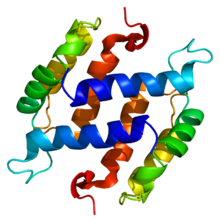S-100 protein
| S100/ICaBP type calcium binding domain | |||||||||
|---|---|---|---|---|---|---|---|---|---|

Structure of the S100B protein. Based on PyMOL rendering of PDB 1b4c.
|
|||||||||
| Identifiers | |||||||||
| Symbol | S_100 | ||||||||
| Pfam | PF01023 | ||||||||
| InterPro | IPR013787 | ||||||||
| PROSITE | PDOC00275 | ||||||||
| SCOP | 1cnp | ||||||||
| SUPERFAMILY | 1cnp | ||||||||
|
|||||||||
| Available protein structures: | |
|---|---|
| Pfam | structures |
| PDB | RCSB PDB; PDBe; PDBj |
| PDBsum | structure summary |
The S100 proteins are a family of low-molecular-weight proteins found in vertebrates and characterized by two calcium-binding sites that have helix-loop-helix ("EF-hand type") conformation. There are at least 21 different S100 proteins. They are encoded by a family of genes whose symbols use the S100 prefix, for example, S100A1, S100A2, S100A3. They are also considered as Damage-associated molecular pattern molecules (DAMPs) and knockdown of AHR downregulates the expression of S100 proteins in THP-1 cells.
Most S100 proteins are homodimeric, consisting of two identical polypeptides, which are held together by non-covalent bonds. S100 proteins are structurally similar to calmodulin. On the other hand, they differ from calmodulin on the other features. For instance, their expression pattern is cell-specific, i.e. they are expressed in particular cell types. Their expression depends on environmental factors. To contrast, calmodulin is a ubiquitous and universal intracellular Ca2+ receptor widely expressed in many cells.
S100 proteins are normally present in cells derived from the neural crest (Schwann cells, and melanocytes), chondrocytes, adipocytes, myoepithelial cells, macrophages, Langerhans cells,dendritic cells, and keratinocytes. It may be present in some breast epithelial cells.
S100 proteins have been implicated in a variety of intracellular and extracellular functions. S100 proteins are involved in regulation of protein phosphorylation, transcription factors, Ca2+ homeostasis, the dynamics of cytoskeleton constituents, enzyme activities, cell growth and differentiation, and the inflammatory response. S100A7 (psoriasin) and S100A15 have been found to act as cytokines in inflammation, particularly in autoimmune skin conditions such as psoriasis.
...
Wikipedia
